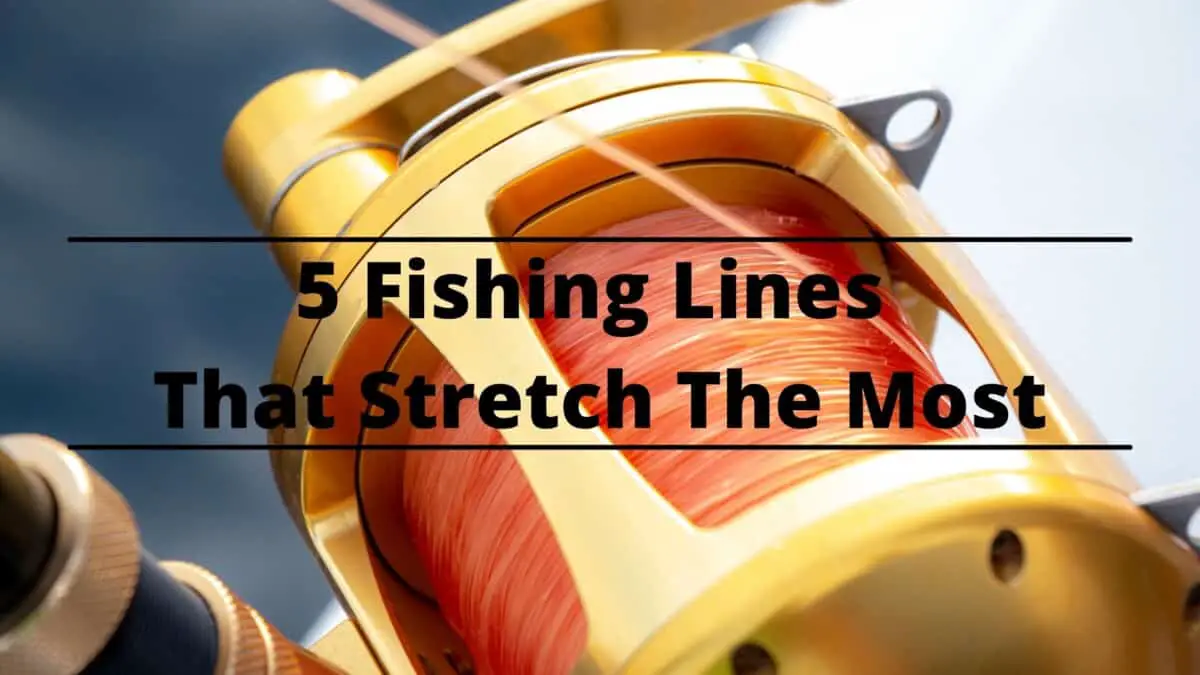Fishing lines are cords designed and used for angling. They resemble a thin, long string but vary in materials.
Early fishing lines were believed to have been used in 1596, according to Leonard Mascall’s book that shows the use of a hook attached to a line made of silkworm or horse hair. In 1667, fishing lines were made of catgut, a type of cord made from natural fibers found in the walls of animal intestines. Then, around 1724, people used silk fishing lines.
Modern fishing lines are almost entirely made of artificial substances and are intended for different types of casting reels. Some fishing lines are very elastic and can stretch up to 10% without any permanent damage. This line stretch can act as a shock absorber when fighting strong fish or setting the hook. However, there also are some downsides to a fishing line stretch. Read along to find out more about this.
A lot of fishing rods and reels can last a lifetime, handle a wider variety of fish, and can take a beating. Whether you are looking for your very first fishing rod or want to buy a new one, we’re sure that our list holds a lot of options. Read our article to discover our best fishing rods recommendations.
Are fishing lines stretchy?
All modern fishing lines have some stretch, but because some are more elastic than others, each is used in different situations. Some fishing lines have no stretch at all to provide more sensitivity when a fish bites, while also allowing for better lure movement. However, they can weigh your rod down and are less abrasion-resistant.
5 Types of Fishing Lines
Here, we explain the five types of fishing lines, their advantages and disadvantages, and how much they stretch.
1. Monofilament
This is a good all-around fishing line that is smooth and a bit stretchy. Monofilament lines stretch up to 25% but have low memory, so they could go back to normal after they have been stretched. They are made of nylon, which is extruded in a single continuous filament and then left untwisted. Additionally, there is also a thermal filament fishing line with higher performance and that is produced by thermal bonding small fibers. However, these are less readily available and a bit more expensive.
On the other hand, monofilament lines are affordable and readily available. They are easy to tie knots with and are available in special shades. However, they are not as strong as other types of lines and break down over time in direct sunlight. Plus, they are more visible in the water.
When to use it:
Monofilament lines can be used on a baitcaster or spinning reel and are best for freshwater fishing, inshore, onshore, and even off a pier. They are good for small and large native types of fish, such as salmon, trout, and even small tuna, kingfish, snapper, and flathead.
Our top choice: STREN Original Monofilament Fishing Line
This one is our top pick for a monofilament fishing line because it has a UV Guard that extends its lifespan. It provides a perfect balance between strength and handling, is abrasion resistant, and has low memory for easy casting and handling.
2. Braided Fishing Line
This type of fishing line is made of synthetic plastic fibers, like nylon, and specialty materials such as Dacron. It is stronger than a monofilament line and has a very little stretch. Indeed, braided lines stretch less than 3% and a little more than 5% before breaking. This stretch makes them less likely to absorb shock but provides more sensitivity to allow anglers to feel every move from the other end of the line.
Braided fishing lines have a smaller diameter but are very strong. They also sink faster and cast farther, allow for sensitivity and better lure movement, and are less visible to fish than monofilament lines. However, because they are strong, they are difficult to cut and slippery, which means knots are trickier to master. These types of lines are also less abrasion-resistant than monofilament lines and more expensive.
When to use it:
Braided fishing lines are best used for saltwater fishing or the offshore trolling of large tuna, marlin, large kingfisher, and sharks. Avoid this type of line if you prefer a stretchier fishing line, notably when trolling for salmon.
Our top choice: KastKing Braided Fishing Line
This product is our top choice because it has a strong knot strength and a smaller diameter to allow you to easily tie knots. It also has low memory for better and farther casting. Plus, its ultra-high sensitivity and zero stretch will allow for a superior hook setting.
3. Fluorocarbon Fishing Line
Similar to monofilament lines, fluorocarbon lines are also extruded in a single strand, but the molecules are more tightly packed, making them denser and noticeably heavier than monofilament lines. Fluorocarbon refers to a broad family of compounds, which include organics composed of chlorine, fluorine, and carbon, along with synthetics derived from hydrocarbons. Lab tests have shown that fluorocarbon lines stretch up to 20% and up to 30% before snapping.
Fluorocarbon fishing lines are practically invisible to fish and less stretchy than monofilament fishing lines, hence why they are abrasion-resistant. They are also water-resistant and dense, sink extremely fast, and are more sensitive. However, they are stiffer and prone to line memory, which means they are less manageable. They are more expensive than other types of lines, and tying knots using this type of line requires you to moisten it first.
When to use it:
Fluorocarbon fishing lines sink easily, hence why they are best used for bottom fishing, such as bottom bouncing or jigging. Additionally, because it still has a bit of stretch, it can also be used for trolling. These are also commonly used as “leaders” to increase your chances of hooking and catching fish while preventing you from having to cast a whole spool of heavier material.
Our top choice: RUNCL PowerFluoro Fishing Line
This hybrid line is constructed with 100% fluorocarbon outer coating and copolymer core to produce maximum shock strength, abrasion resistance, and reduce memory. It is fast sinking, has low stretch, and extra sensitivity, so you can feel even the slightest fish bites.
Your fishing rod and reel are the most vital components to catch fish, therefore, you must clean them after each use. Knowing how to properly care for and maintain your fishing rod and reel is important to make your investment last many years. Read our article to learn how to take care of your fishing rod and reel.
4. Spectra and Dyneema
In addition to the types of fishing lines listed above, you should note that more materials are used to create fishing lines. Although nylon remains the most popular and cost-effective one, newer materials, such as Spectra, Dacron, and Dyneema, are also available.
Spectra and Dyneema, these are modern brand names that refer to an ultra-strong polyethylene fiber used for high-tech fishing lines. These materials are stronger than steel and more durable than polyester. However, they come at a higher price. Although, it can be worth it due to their ability to reduce the weight of your tackle by increasing the amount of line that fits into the spool. This type of material offers more sensitivity, knot strength, and abrasion resistance, along with low stretch and almost no memory.
Our top choice: Power Pro Spectra Fiber Fishing Line and Spearfishing World Dyneema Cored Line
and Spearfishing World Dyneema Cored Line
The Power Pro Spectra fishing line is made with enhanced body technology for increased handling performance. It is incredibly smooth, round, and sensitive. Plus, the spectra fiber allows for incredible abrasion resistance.
The Spearfishing World Dyneema is a fishing line specifically designed for speargun reels, preferably with a cylindrical shape and good grip. It is made with a high abrasion-resistant polyester outer jacket braid and a Dyneema core, which allows for great tensile strength.
5. Dacron
This material was created by DuPont in the late 1950s, just 20 years after the invention of nylon. It is a long-chain polyester that is slightly improved compared to nylon when it comes to flexibility, strength, and low stretch.
Our top choice: Tuf Line Dacron Fishing Line
The Tuf Line Dacron fishing line is made of a combination of Dacron fibers and the most advanced braiding machines to provide low stretch, allowing for quicker response and increased sensitivity. It is also meant to eliminate strength loss and reduce the chances of losing fish.
Conclusion
You won’t be able to fish properly without a fishing line. Lucky for us modern anglers, fishing lines have been developed tremendously and are much easier to acquire than before. Because of modern technology, we now have fishing lines that are sturdier and more versatile than ever.
There is an ideal fishing line for every kind of fishing activity. Depending on your location as well as the type of fish that you want to catch, there is a fishing line that will help you fish to the fullest of your abilities. Remember the information that we shared above when it’s time to choose a fishing line so that you’ll be able to get one that will allow you to enjoy your fishing trip to the fullest.


